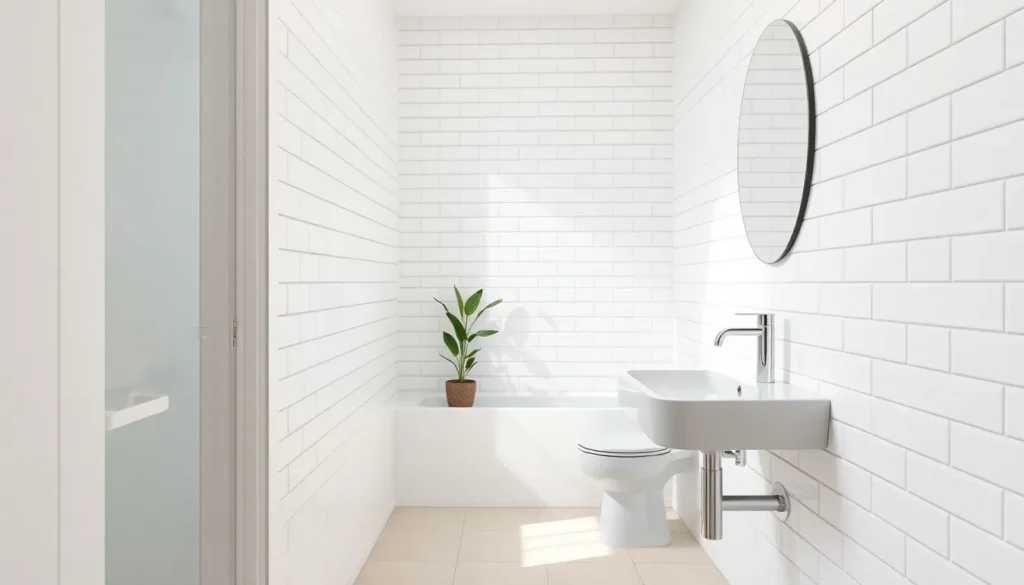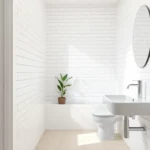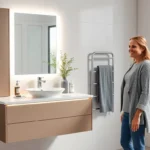Small bathrooms don’t have to feel cramped or uninspiring. We’ve discovered that the right tile choices can completely transform your compact space into a stunning sanctuary that feels twice its actual size. The secret lies in understanding how different tile patterns, colors, and sizes work together to create visual magic.
We know you’re looking for practical answers that deliver maximum impact without very costly. That’s why we’ve compiled the most effective tile strategies that interior designers use to make small bathrooms appear larger, brighter, and more luxurious.
From clever color schemes that reflect light to strategic patterns that draw the eye upward, these bathroom tile ideas will revolutionize how you see your space. Whether you’re planning a complete renovation or a simple refresh, we’ll show you exactly how to choose tiles that make every square inch count.
Choose Light-Colored Tiles to Maximize Natural Light
Light-colored tiles reflect more natural light than darker alternatives, creating the illusion of a larger bathroom space. We’ve found that lighter hues can increase the perceived brightness of small bathrooms by up to 40% compared to darker tile choices.
White Subway Tiles for Timeless Appeal
White subway tiles remain the most popular choice for small bathroom renovations, offering clean lines and maximum light reflection. These rectangular tiles measuring 3×6 inches create a classic backdrop that never goes out of style while making your bathroom feel significantly more spacious.
Installing subway tiles vertically draws the eye upward and creates the impression of higher ceilings. We recommend using white grout to maintain seamless continuity and prevent visual breaks that could make the space feel choppy. The glossy finish on ceramic subway tiles bounces light around the room more effectively than matte alternatives.
Beveled edges on subway tiles add subtle dimension without overwhelming small spaces. This detail catches light at different angles throughout the day, creating natural highlights that enhance the overall brightness of your bathroom.
Cream and Beige Tones for Warmth
Cream and beige tiles provide the space-improving benefits of light colors while adding warmth that pure white sometimes lacks. These neutral tones work particularly well in bathrooms with limited natural light, as they create a cozy yet open atmosphere.
Travertine-look porcelain tiles in cream shades offer the luxury appearance of natural stone without the maintenance requirements. We’ve seen these tiles transform cramped bathrooms into spa-like retreats while maintaining the light-reflecting properties essential for small spaces.
Beige ceramic tiles with subtle texture prevent the monotonous appearance that can occur with solid color schemes. The slight variation in tone adds visual interest while keeping the overall palette light and airy.
Light Gray Options for Modern Sophistication
Light gray tiles deliver contemporary elegance while maintaining the brightness small bathrooms need to feel spacious. Gray reflects approximately 25% more light than medium-toned colors, making it an excellent compromise between stark white and darker hues.
Large format light gray tiles measuring 12×24 inches minimize grout lines and create uninterrupted surfaces that expand visual space. We recommend installing these tiles in a brick pattern to add movement without sacrificing the clean, modern aesthetic.
Marble-look gray porcelain provides the luxurious appearance of natural stone with enhanced durability and water resistance. The subtle veining in these tiles adds sophisticated detail while the light base color keeps your bathroom feeling open and bright.
Select Large Format Tiles to Create Visual Expansion
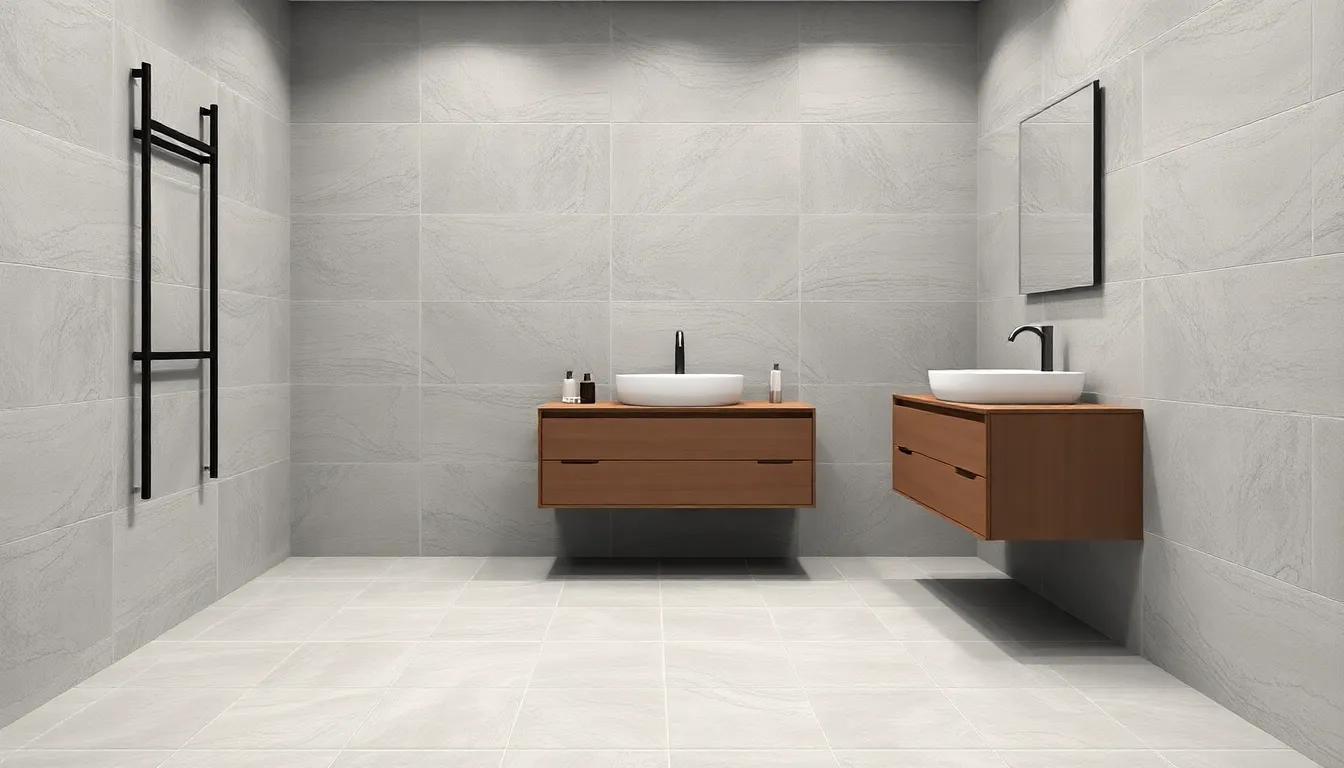
Large format tiles work exceptionally well in small bathrooms because they minimize grout lines and create a more cohesive visual flow throughout the space.
12×24 Inch Tiles for Fewer Grout Lines
12×24 inch tiles minimize grout lines significantly, which helps create that seamless look we’re after in compact bathrooms. These rectangular tiles reduce visual interruptions across your floor and walls, making the entire space feel more expansive and unified.
Installing these tiles creates a streamlined appearance that draws the eye across longer sight lines rather than breaking up the visual field with many grout intersections. We recommend using matching grout color to further enhance this seamless effect.
Positioning 12×24 tiles horizontally on walls can make your bathroom appear wider, while vertical installation creates the illusion of higher ceilings. This flexibility allows you to customize the visual impact based on your exact space constraints.
Oversized Square Tiles for Contemporary Look
Oversized square tiles provide a contemporary aesthetic while maximizing the visual expansion benefits we want in small bathrooms. These large format options, typically measuring 24×24 inches or larger, create bold, uninterrupted surfaces that modern design enthusiasts love.
Contemporary square tiles work particularly well when you want to establish a uniform, expansive feel throughout your bathroom. The clean geometric lines complement minimalist fixtures and create a sophisticated backdrop for your design elements.
Large square formats reduce maintenance requirements since fewer grout lines mean less cleaning and upkeep over time. This practical benefit makes them an excellent long term investment for busy homeowners.
Plank-Style Tiles for Length Illusion
Plank style tiles create remarkable length illusions when installed horizontally across your bathroom floor or walls. These elongated tiles, which mimic wood planks, guide the eye along their length and make narrow bathrooms appear significantly wider.
Horizontal installation maximizes the length effect by creating continuous sight lines that stretch across your entire space. We’ve seen this technique make cramped bathrooms feel almost twice as wide as their actual dimensions.
Wood look plank tiles offer versatility in both traditional and contemporary bathroom designs while providing the visual expansion benefits of large format tiles. The natural grain patterns add texture and warmth without overwhelming small spaces.
Implement Vertical Tile Patterns to Add Height
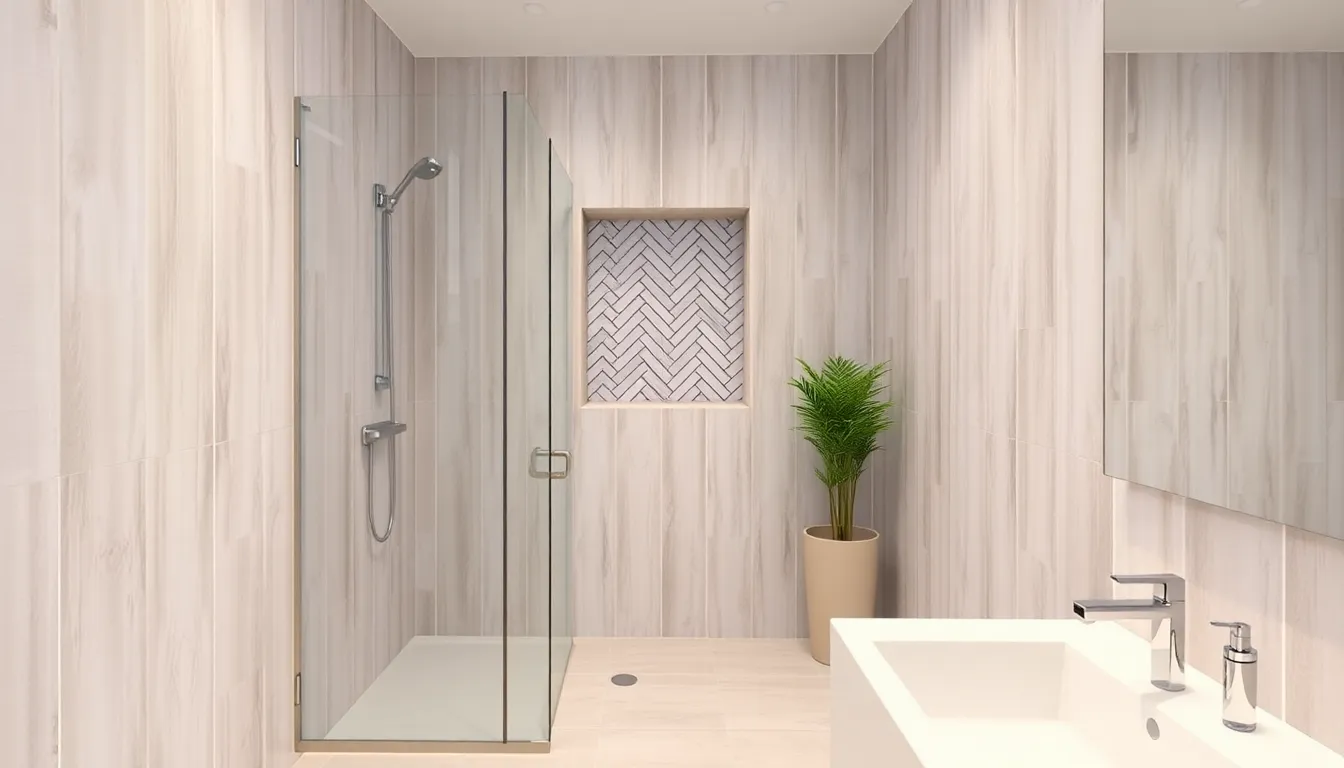
Vertical tile arrangements create an immediate sense of upward movement that draws the eye toward the ceiling. We’ve seen this technique transform cramped bathrooms into spaces that feel significantly taller and more open.
Floor-to-Ceiling Installations
Floor-to-ceiling tile installations eliminate harsh horizontal breaks that can make walls appear shorter. We recommend using large-format tiles or continuous runs of rectangular tiles in light, neutral colors to create this unified look. The absence of visual interruptions allows the eye to travel smoothly from floor to ceiling, making the entire space feel more expansive.
Rectangular subway tiles work particularly well for this application when arranged in vertical stacks. Light colors enhance the cohesion and openness of the space while reducing visual clutter. We’ve found that this technique is most effective when you maintain consistent grout lines and avoid mixing different tile sizes on the same wall.
Stacked Bond Pattern for Clean Lines
Stacked bond layouts align tiles in straight vertical and horizontal lines, creating a grid-like appearance that offers visual enlargement. We prefer this classic pattern with subway tiles or square formats because it maintains clean, streamlined aesthetics. The geometric precision of stacked bonds helps small bathrooms feel more organized and spacious.
Bright grout maintains a continuous, clean appearance that enhances the pattern’s effectiveness. We’ve observed that this layout works exceptionally well on accent walls behind vanities or in shower areas. The simplicity of the stacked pattern prevents visual overwhelm while still adding textural interest to vertical surfaces.
Herringbone Layout for Visual Interest
Herringbone patterns arrange rectangular tiles at 45-degree angles in zigzag formations that add texture and movement without overwhelming compact spaces. We recommend this layout for accent walls or flooring applications where you want to introduce visual depth. The diagonal orientation creates ever-changing lines that can make walls appear wider or longer depending on the installation direction.
This pattern works best when balanced with simpler tile arrangements on other surfaces to avoid visual chaos. We’ve found that herringbone layouts are particularly effective in shower niches or behind floating vanities where they can serve as focal points without dominating the entire bathroom design.
Use Glossy Finishes to Reflect Light and Space
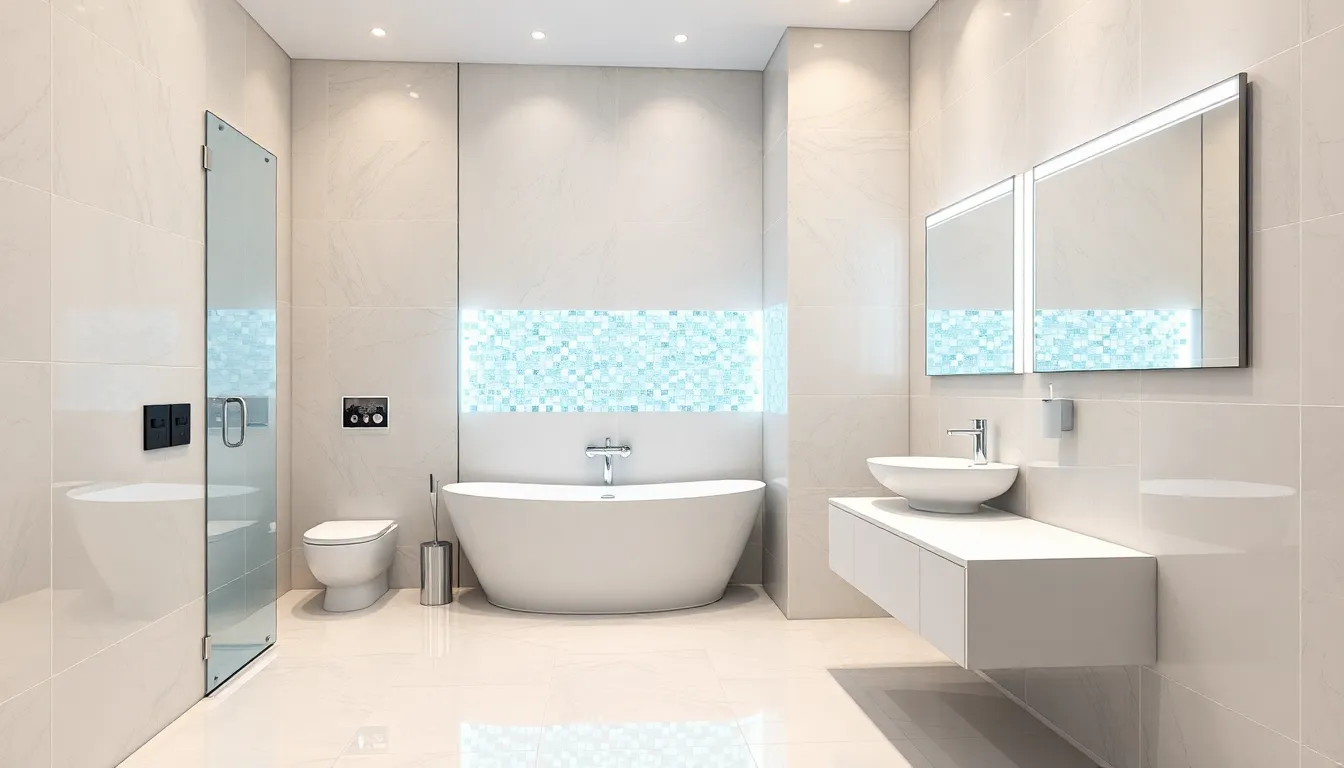
Glossy finishes transform small bathrooms by bouncing light throughout the space and creating an illusion of expanded square footage. We’ve found that reflective surfaces can make rooms appear up to 30% larger than their actual dimensions.
High-Gloss Ceramic Benefits
High-gloss ceramic tiles deliver exceptional light reflection that makes small bathrooms feel more spacious and brighter. We recommend these tiles because they’re incredibly easy to clean with just a damp cloth, which is essential in moisture-heavy environments. Their smooth surface prevents soap scum and grime buildup better than textured alternatives.
Maintenance becomes effortless with high-gloss ceramics since water spots and fingerprints wipe away quickly. We’ve noticed that homeowners save important time on bathroom cleaning when they choose these reflective surfaces. Budget-conscious renovators appreciate that ceramic options cost 40-60% less than natural stone while providing similar visual impact.
Polished Porcelain Advantages
Polished porcelain tiles offer superior durability compared to ceramic while maintaining excellent light-reflecting properties. We trust these tiles in bathroom applications because they resist moisture penetration better than most alternatives, preventing long-term damage from steam and splashes. Their non-porous surface makes them naturally antimicrobial.
Design versatility sets polished porcelain apart since manufacturers create styles that mimic marble, wood, and concrete with stunning realism. We’ve seen these tiles maintain their glossy finish for decades without dulling or scratching under normal use. Installation costs remain reasonable while providing premium aesthetics that rival natural materials.
Glass Tiles for Maximum Reflection
Glass tiles provide unmatched light reflection that can double the perceived brightness in small bathroom spaces. We position these tiles strategically as accent walls behind vanities or in shower niches to create dramatic focal points without overwhelming the room. Their transparent quality allows light to pass through and bounce off surfaces behind them.
Luxury appeal comes naturally with glass tiles since they create depth and dimension that flat surfaces can’t match. We’ve found that combining glass tiles with LED backlighting creates stunning visual effects that make bathrooms feel like high-end spas. Subway-style glass tiles work particularly well for maintaining classic aesthetics while maximizing reflective benefits.
Create Accent Walls with Bold Tile Choices
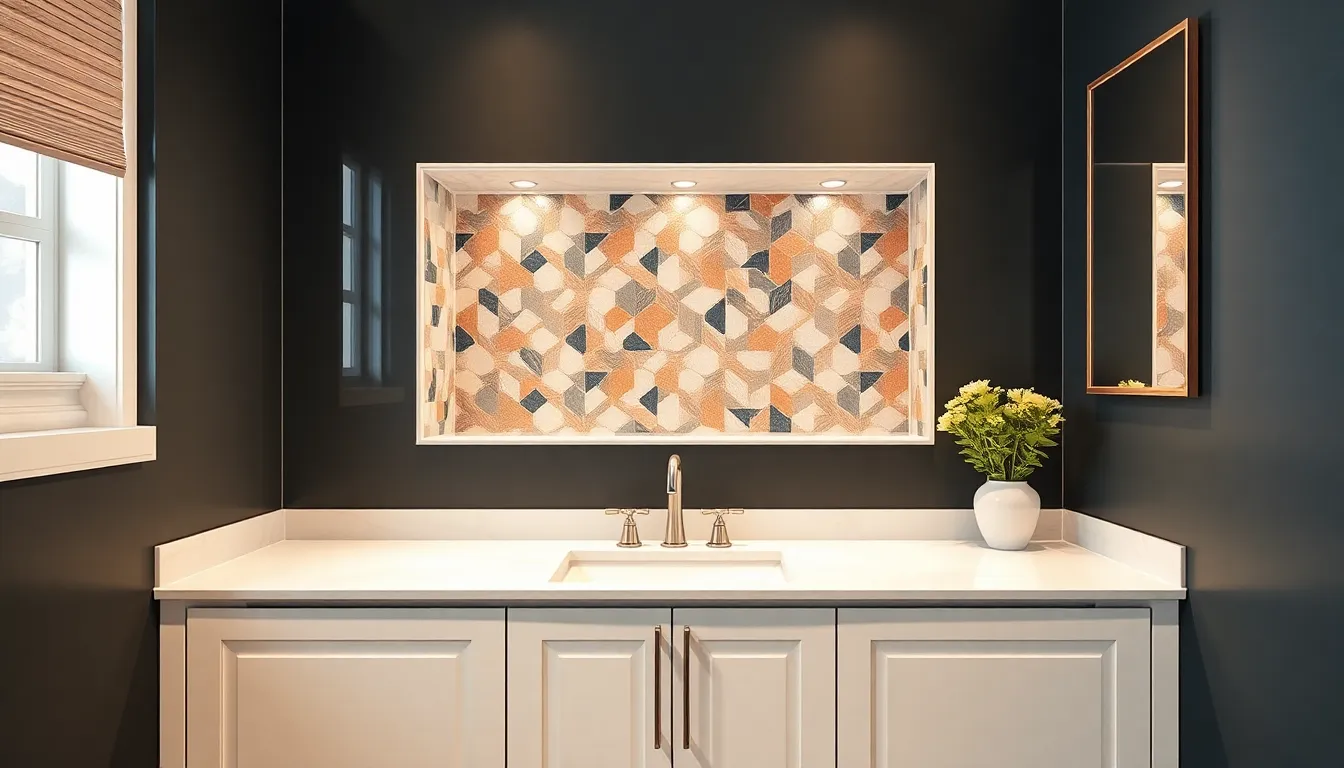
Bold tile patterns can transform small bathrooms from ordinary to extraordinary. Creating strategic focal points with accent walls helps maximize visual impact while maintaining the spacious feel we’ve already established with light colors and large formats.
Feature Wall Behind Vanity
We recommend designating the wall behind your vanity as a feature wall using distinct tiles that contrast with your main tile selection. Bold patterned tiles like the Nikki Chu Zulu Graphite tile introduce playful elements while maintaining an elevated design aesthetic when paired with modern fixtures.
Consider selecting tiles with geometric patterns or rich textures for this focal point. These choices draw attention to the vanity area and create depth in compact spaces. Contrasting colors between your feature wall and surrounding tiles establish clear visual boundaries that enhance the room’s overall appeal.
Shower Niche Highlighting
Highlighting your shower niche with different tiles creates personalized depth and visual interest within the shower area. Using contrasting tile colors or patterns for niche interiors transforms functional storage into a design feature that catches the eye.
We suggest selecting tiles that complement but don’t match your main shower tiles exactly. This approach creates subtle contrast without overwhelming the space. Small format tiles or mosaic patterns work particularly well in niches because they accommodate curved edges and corners more easily than large format options.
Mosaic Tile Borders
Incorporating mosaic tile borders adds artistic touches that enhance small bathroom aesthetics without consuming excessive space. These decorative elements create visual separation between different areas and frame exact features like shower zones or vanity backsplashes.
Strategic border placement can guide the eye through your bathroom’s layout and highlight key design elements. We recommend using mosaic borders at transition points between different tile areas or as accent strips within larger tile installations. Glass mosaic borders reflect additional light while ceramic options provide texture and color variation that complements your overall tile scheme.
Install Continuous Flooring to Unify the Space
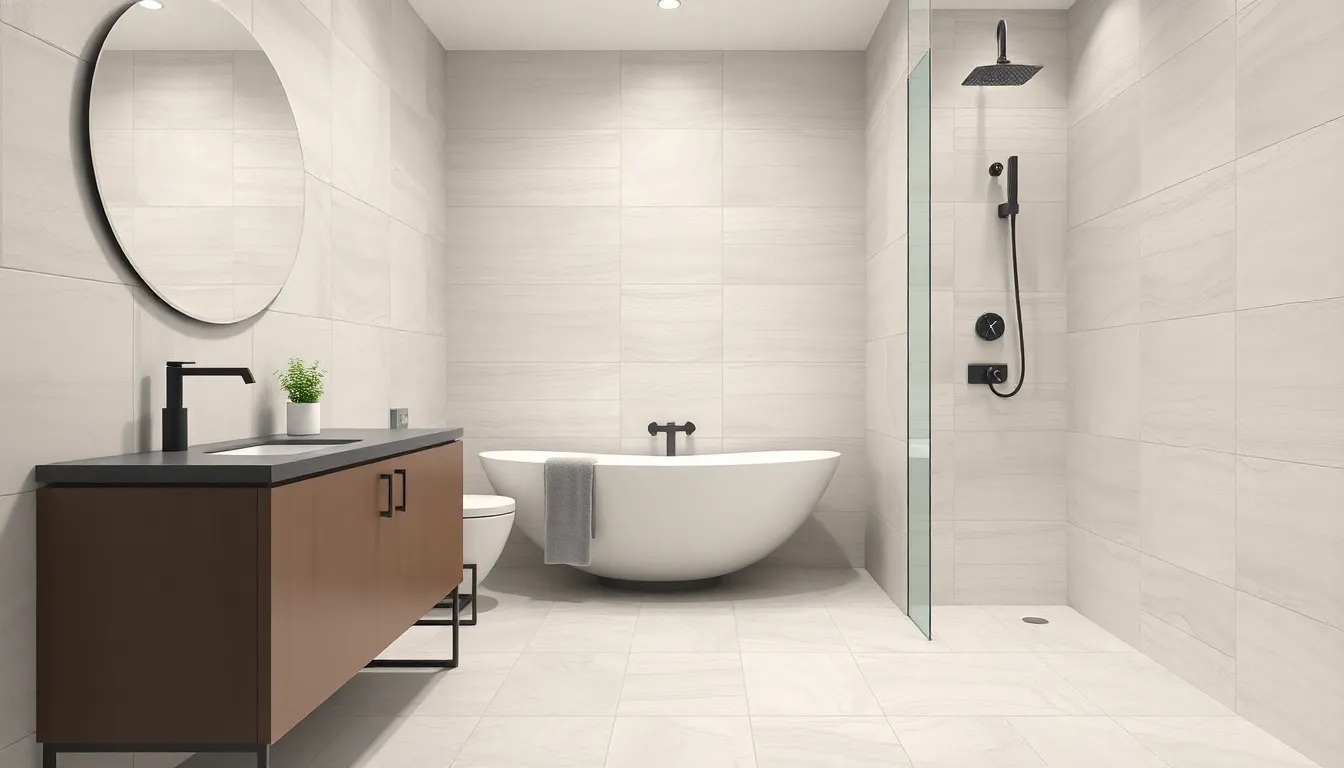
Creating a cohesive foundation throughout your small bathroom eliminates visual breaks that fragment the space. We recommend selecting the same tile for your entire bathroom floor to achieve this unified appearance that makes rooms feel larger and more expansive.
Extending Floor Tiles Up Shower Walls
Extending your floor tiles up the shower walls creates seamless flow between surfaces. This technique blurs the boundaries that typically separate different areas of your bathroom, making the space feel more open and connected. Large format tiles work exceptionally well for this approach since they minimize grout lines and reduce visual interruptions.
Applying floor tiles to both ground and wall surfaces in the shower area eliminates the harsh transitions. You can extend tiles up the lower portions of shower walls or cover entire wall surfaces for maximum impact. This continuous surface treatment helps your eye move smoothly across the space without stopping at material changes.
Choosing the same tile for floors and shower walls reduces the perception of tight spaces. The unbroken visual plane created by consistent materials tricks the eye into seeing a larger area than actually exists. We’ve found this technique particularly effective when combined with minimal grout lines in matching colors.
Seamless Transitions Between Areas
Seamless transitions between your shower and main bathroom area maintain visual flow throughout the space. Avoiding abrupt changes at doorways or between different zones keeps your eye moving smoothly across the entire room. This continuity creates the illusion of expanded square footage in compact bathrooms.
Consistent tile size and color in adjacent zones helps unify separate areas. Your shower curb should blend seamlessly into the main floor using the same tile material and pattern. This approach eliminates the visual stops that make small spaces feel chopped up and disconnected.
Implementing slight elevation changes with the same tile maintains uniform appearance. You can create necessary slopes for drainage in shower areas while preserving the continuous look of your flooring material. This technique allows for proper water management without sacrificing the visual expansion benefits of consistent surfaces.
Monochromatic Color Schemes
Monochromatic color schemes simplify the visual industry and broaden your bathroom’s perceived size. Choosing tiles in the same or closely related colors for walls, floors, and showers creates a cohesive palette that doesn’t compete for attention. This unified approach makes your small bathroom feel more spacious and serene.
Light neutrals reflect more light and make areas feel airier than darker alternatives. We recommend white, gray, or soft beige tiles as your foundation colors since they maximize natural and artificial light reflection. These colors can increase perceived brightness by important amounts while maintaining a timeless aesthetic.
Monochromatic schemes pair beautifully with subtle patterns or textures for added interest. You can introduce visual variety through tile finish differences or gentle geometric patterns without overwhelming your compact space. This approach adds personality while preserving the space improving benefits of consistent color throughout your bathroom.
Consider Textured Tiles for Depth Without Clutter
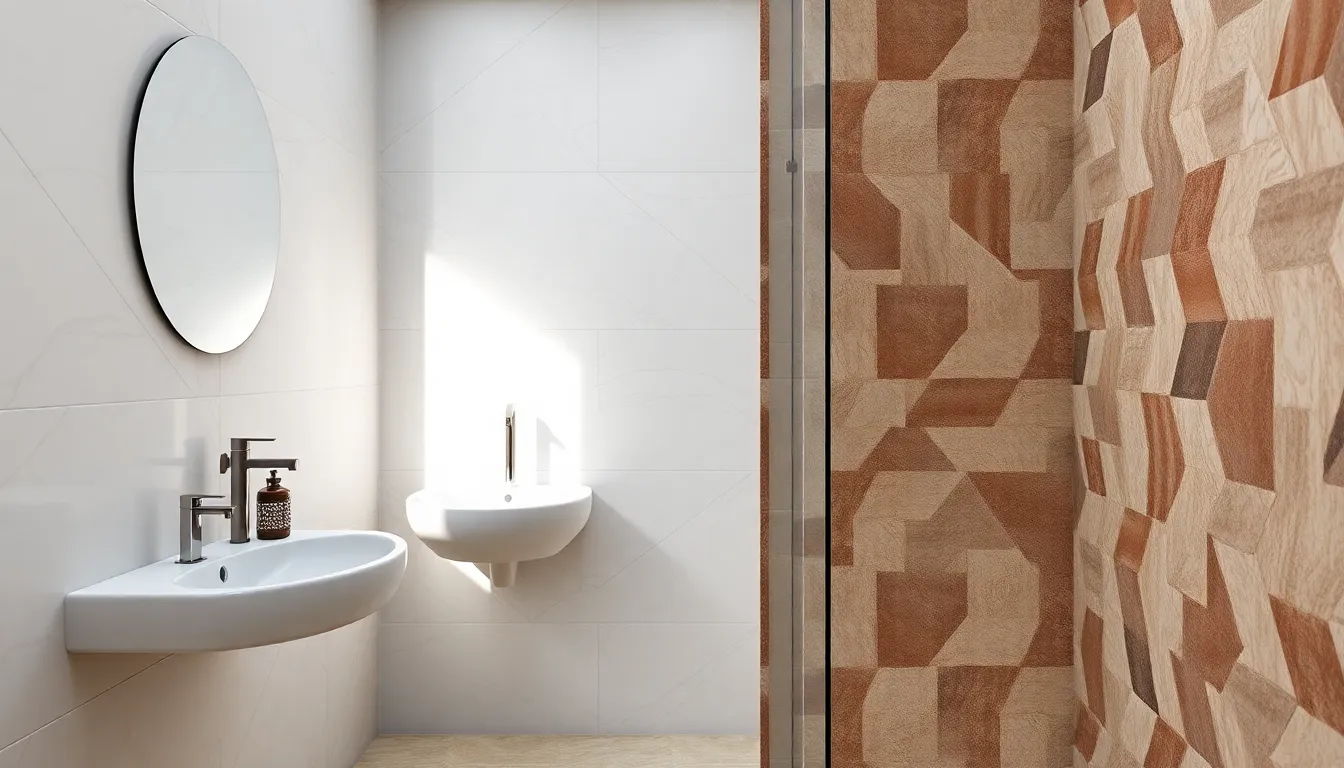
Textured tiles create visual interest and dimensional appeal without adding physical bulk to your small bathroom space. Strategic texture placement can add warmth and depth while maintaining the clean, uncluttered aesthetic that makes compact bathrooms feel more spacious.
Subtle Raised Patterns
Subtle raised patterns provide visual interest without overwhelming small bathroom spaces. These delicate textures catch light at different angles, creating shadows that add depth to walls while maintaining a sophisticated appearance. Wave patterns, linear ridges, and gentle geometric embossments work particularly well in compact areas because they create movement without competing for attention.
Raised hexagon tiles offer a contemporary touch that feels both modern and timeless. The slight elevation creates gentle shadows throughout the day as natural light shifts, adding ever-changing visual appeal to your bathroom walls. Linen texture tiles mimic fabric patterns with subtle raised threads that provide tactile interest while reflecting light beautifully.
Natural Stone Textures
Natural stone textures like marble and granite bring warmth and organic depth to small bathroom designs. Marble look porcelain tiles deliver the luxurious appearance of natural stone while offering superior durability and lower maintenance requirements. The natural veining patterns create visual movement that draws the eye across surfaces, making walls appear larger than their actual dimensions.
Travertine textures add Mediterranean elegance with their characteristic pitted surfaces and warm undertones. These tiles work exceptionally well in cream and beige color palettes, providing the light reflecting benefits discussed earlier while introducing subtle texture variation. Slate look tiles offer a more contemporary approach with their fine grain patterns and sophisticated color variations.
Granite inspired textures combine speckled patterns with subtle surface variation that adds interest without creating visual chaos. The natural mineral patterns help disguise water spots and soap residue, making them practical choices for shower areas and high use zones.
3D Geometric Designs
3D geometric designs create ever-changing visual impact when used strategically in small bathroom spaces. Dimensional hexagon tiles arranged in honeycomb patterns add architectural interest to accent walls without overwhelming the overall design scheme. Triangle and diamond shaped tiles with raised surfaces create bold statements that work best when limited to single feature walls.
Cube pattern tiles offer an optical illusion effect that can make flat walls appear to have depth and dimension. The geometric shadows change throughout the day, providing constant visual variety that keeps small spaces feeling fresh and captivating. Chevron raised patterns create directional movement that can guide the eye toward exact focal points like vanity areas or shower niches.
Wave pattern 3D tiles bring organic movement to geometric spaces, softening harsh angles while maintaining contemporary appeal. These designs work particularly well behind floating vanities where the shadows can be appreciated without interference from cabinetry or fixtures.
Incorporate Mirror Tiles for Double Light Reflection
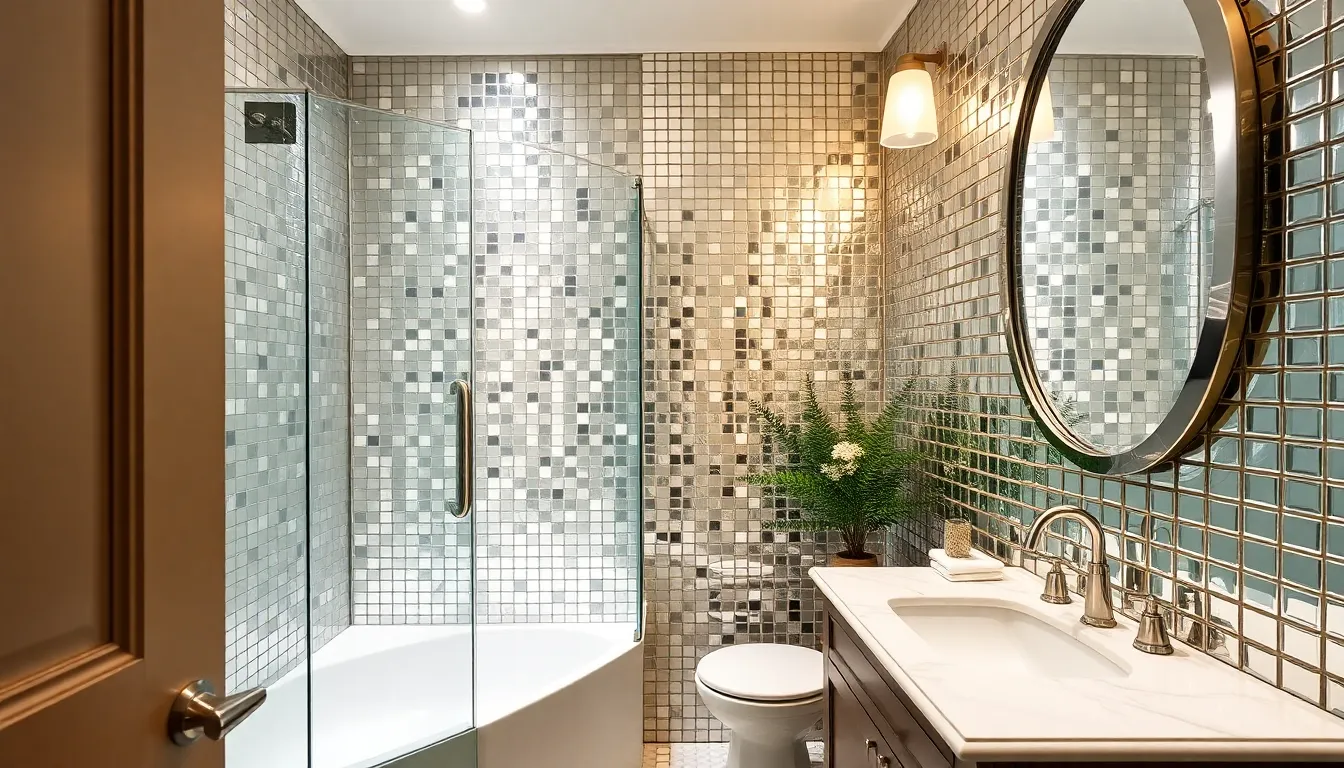
Mirror tiles transform small bathrooms by doubling the available light and creating dramatic spatial illusions. We’ll explore how these reflective surfaces can make your compact bathroom feel twice as spacious.
Mirrored Mosaic Accents
Mirrored mosaics deliver elegance while maximizing light reflection from multiple angles throughout your bathroom. These tiles create sophisticated focal points that bounce light in various directions, making spaces feel significantly larger than their actual dimensions.
Small mosaic pieces work exceptionally well as shower wall accents or vanity backsplashes. Each individual mirror segment reflects light differently, creating ever-changing brightness patterns that shift throughout the day. We recommend using these mosaics sparingly to avoid overwhelming the space while still achieving maximum visual impact.
Installation works best when:
- Positioned opposite natural light sources
- Used in 2×2 foot accent sections
- Combined with neutral base tiles
- Placed at eye level for optimal reflection
Antique Mirror Tiles
Antique mirror tiles bring vintage charm while adding depth and character to small bathroom spaces. These weathered reflective surfaces create luxurious focal points that make rooms feel more spacious and historically rich.
Distressed mirror finishes offer subtle reflection without the stark brightness of new mirrors. We find these tiles particularly effective when used as accent strips or feature wall sections. Their aged patina softens harsh lighting while maintaining space improving properties.
Popular antique mirror applications include:
- Vertical strips behind vanities
- Shower niche backgrounds
- Border accents around standard tiles
- Single feature wall installations
Strategic Placement Tips
Large format tiles reduce grout lines and create cohesive looks that make small spaces feel more expansive. We recommend 12×24 inch or larger mirror tiles to minimize visual breaks and maximize reflection surface area.
Mix tile styles strategically by combining mirrored elements with complementary materials like subway or natural stone tiles. This approach adds visual interest without creating overwhelming busy patterns that can make spaces feel cramped.
Avoid uniform coverage throughout the entire bathroom, as too much mirror can create disorienting effects. Instead, designate exact areas like shower walls, vanity backsplashes, or single accent walls for mirror tile installation.
Strategic lighting placement maximizes mirror tile effectiveness by positioning fixtures to bounce light across reflective surfaces. Install LED strips above or below mirror sections to create ambient lighting that enhances the spacious feeling these tiles provide.
Conclusion
We’ve explored many tile strategies that can transform your small bathroom from cramped to spacious. The right combination of color, pattern, and texture makes all the difference in creating an illusion of expanded space.
Remember that light colors, large formats, and strategic patterns work together to maximize both natural and artificial light. Whether you choose glossy finishes for reflection or textured surfaces for depth, each decision contributes to your bathroom’s overall visual impact.
Don’t be afraid to experiment with accent walls or mirror tiles to add personality while maintaining that open feel. Start with one or two of these techniques and build from there – your small bathroom has more potential than you might think.
Frequently Asked Questions
What tile colors work best for making small bathrooms look bigger?
Light-colored tiles are the most effective choice for small bathrooms. White, cream, beige, and light gray tiles can increase perceived brightness by up to 40%. These colors reflect natural light and create an airy, spacious feel. White subway tiles are particularly popular for their timeless appeal and light-reflecting properties.
How do large format tiles help small bathrooms appear larger?
Large format tiles create fewer grout lines, resulting in a more seamless and unified appearance. Popular sizes like 12×24 inches or 24×24 inches minimize visual interruptions and make the space feel less fragmented. The reduced grout lines also mean less maintenance and a cleaner overall look.
Should I use glossy or matte tiles in a small bathroom?
Glossy finishes are ideal for small bathrooms as they reflect light and can make spaces appear up to 30% larger. High-gloss ceramic and polished porcelain tiles offer excellent light reflection while being easy to clean. However, consider slip resistance for floor applications.
What tile patterns make small bathrooms look taller?
Vertical tile arrangements and floor-to-ceiling installations create upward movement that draws the eye toward the ceiling. Installing subway tiles vertically instead of horizontally can create the illusion of higher ceilings. Stacked bond patterns also maintain clean lines that enhance the sense of height.
How can I use accent walls effectively in a small bathroom?
Create strategic focal points by designating one wall, typically behind the vanity, as a feature wall with contrasting tiles. Use bold patterns or geometric designs sparingly to add visual interest without overwhelming the space. Highlighting shower niches with different tiles also adds depth and personality.
Are mirror tiles good for small bathrooms?
Yes, mirror tiles can double available light and create dramatic spatial illusions. Mirrored mosaic accents reflect light from multiple angles, while antique mirror tiles add vintage charm. Use them strategically and sparingly to avoid overwhelming the space – they work well as accent features rather than covering entire walls.
What’s the benefit of continuous flooring in small bathrooms?
Using the same tile throughout the entire bathroom floor eliminates visual breaks and creates a unified appearance. Extending floor tiles up shower walls creates seamless flow and blurs boundaries, enhancing the perception of openness and making the space feel larger overall.
How do textured tiles work in small spaces?
Subtle textured tiles add depth and visual interest without creating clutter. Natural stone textures like marble provide warmth and organic depth, while 3D geometric designs create dynamic visual impact. Choose textures that are sophisticated but not overwhelming to maintain the spacious feel.

